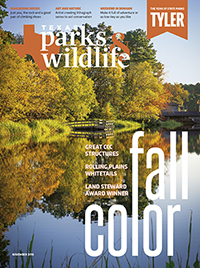
Flora Fact: Powderhorn Petals
Bracted blazing star illuminates coastal prairies each fall.
By Jason Singhurst
Powderhorn Ranch in Calhoun County will become a state park and wildlife management area open to the public in a few years. During a recent biological survey of the tract, Baylor University’s Walter Holmes and Jeff Mink and I were pleased to encounter a large population of bracted blazing star (Liatris bracteata) sure to delight those future visitors.
Bracted blazing star is a globally rare Texas endemic (found nowhere else but Texas) plant that is distributed along the upper and central coast from Houston south to Rockport. This vibrant member of the sunflower family occurs in coastal prairie grasslands of various types.

The perennial’s flowers are found deep in the center — bright purple fluffy disks that resemble “blazing stars.” What may appear to be long, widely spaced “petals” surrounding the flower are actually “bracts,” or specialized leaves (in this case, colored like the flower). Bracted blazing star flowers from late September through November and is especially valuable to native bees, which assist with pollination.
Bracted blazing star is a great coastal prairie native that has been recently used in prairie restoration projects from rescued populations being affected by development. The Houston Chapter of the Native Prairies Association of Texas is reproducing this rare plant from rescued sites and conducts fall field trips to natural populations.
TPWD’s Wildlife Diversity Program works with Texans to conserve rare plant and animal species and areas with high conservation value. We’d like to learn more about populations of bracted blazing star, especially those not yet documented. Together, we can work toward conserving this rare native wildflower that vividly illuminates coastal prairies each fall.
|
Common Names: Bracted blazing star, bracted gayfeather Scientific Name: Liatris bracteata Size: Flower stalks reach up to 2 feet Did You Know? This species is of conservation concern in its native range |
» Like this story? If you enjoy reading articles like this, subscribe to Texas Parks & Wildlife magazine.
Related stories
Flora Fact: A Honey of a Wildflower

